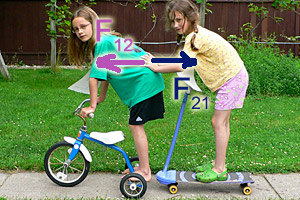Newton's Laws
Euclidean Geometry has Laws, but it's a human construct about abstract mathematical objects, so the laws may be considered exact.The Story of Mathematics
 Newton had the more ambitious goal of describing the physical world with mathematics, and he made a pretty good first draft! We should perhaps more honestly call them "Newton's most-of-the-time pretty-excellent approximations", but that isn't quite as catchy...
teachertech.rice.edu
Newton had the more ambitious goal of describing the physical world with mathematics, and he made a pretty good first draft! We should perhaps more honestly call them "Newton's most-of-the-time pretty-excellent approximations", but that isn't quite as catchy...
teachertech.rice.edu
Mass
 Mass: resistance to acceleration.
$$\frac{F}{a}=m$$
Mass: resistance to acceleration.
$$\frac{F}{a}=m$$
Standard unit 1 kg.
Force
That which is necessary to change the velocity (speed and/or direction) of a particle.
Standard unit 1 N: A force which accelerates a mass of 1 kg by 1 m/sec/sec.
Newton's first law (inertia)
 The idea of a force certainly stems from the feel of pushing/pulling at objects.
The Greeks thought a force was necessary to keep an object in motion. But nowadays, we also recognize a possible "frictional force" which arises to oppose acceleration, following Galileo's ideas:
The idea of a force certainly stems from the feel of pushing/pulling at objects.
The Greeks thought a force was necessary to keep an object in motion. But nowadays, we also recognize a possible "frictional force" which arises to oppose acceleration, following Galileo's ideas:
Galileo noticed that after being pushed, balls on a smooth surface kept moving longer than
flat objects of similar weight on a rough surface.
So Galileo made observations with balls on smooth ramps, and noticed that they

- speed up when going down an inclined plane,
- slow down when going up an inclined plane,
He reasoned that in the "halfway" situation between up and down tilts (that is, rolling on a flat, level plane) balls would neither speed up nor slow down.
In the absence of forces, a particle moves with a constant velocity, $\myv v_0$.
Newton's second law
For a particle of mass $m$, the sum of the forces $\myv{F}$ acting on the particle is precisely $m$ times the acceleration $\myv{a}$. $$\myv{F} = m \myv{a}$$
Or, since the mass of a classical particle is constant, and momentum $p=mv$, we could write the 2nd law as: $$\myv{F} = \dot{\myv{p}}$$
Reference frames
A reference frame is a particular choice of origin and unit vectors with which to measure positions.
An inertial reference frame is one in which Newton's first two laws hold.
This is a frame which is neither accelerating nor rotating. (If you like, rotating frames are one possible kind of accelerating frames!)
Newton's third law (reaction)
If particle 2 exerts a force $\myv{F}_{12}$ on particle 1, then particle 1 always exerts a "reaction force" $\myv{F} _{21}$ equal and opposite in direction on particle 1, $$\myv{F} _{12} = -\myv{F} _{21}$$


Internal and External forces
Generalizing to a system of $N$ particles, let's call $\myv{F} _{\alpha \beta}$, the force exerted by particle $\beta$ on $\alpha$, an internal force -- internal to the system. These are often central forces acting along the line that connects the two particles (e.g. gravity, electro-static forces), but not always (magnetic force).
There may also be a net external force exerted by something other than the N particles acting on $\alpha$ which we'll call $\myv{F} _{\alpha}^{ext}$, such that we could write the net force acting on $\alpha$ as: $$\myv{F} _\alpha = \sum_{\beta=1; \beta \neq \alpha}^N \myv{F} _{\alpha \beta} + \myv{F}_{\alpha}^{ext} = \dot{\myv{p}}_{\alpha}$$

Note that:
The the summation goes over all $\beta = 1...N$ but not $\beta = \alpha $
The term $\myv{F} _{\alpha}^{ext}$ is not summed over.
Total momentum of many particles
The total momentum of a system made up of many particles is the sum of the momenta of each of the particles.
The goal of this section is to show that the total momentum changes in response to the external forces alone--That you may ignore the internal forces between the particles in the system.
Consider a system of $N$ particles. Its total momentum is: $$\myv{P} = \sum_{\alpha} \myv{p}_{\alpha} $$
Taking time derivatives, and using our previous result for the momentum of any member of the system: $$\dot{\myv{P}} = \sum_\alpha \dot{\myv{p}}_\alpha=\sum_\alpha \sum_{\beta \neq \alpha} \myv{F} _{\alpha \beta} + \sum_{\alpha} \myv{F} _{\alpha}^{ext}.$$
Let's write the double-sum out in the case of $N=3$ particles: $$\sum_{\alpha}\sum_{\beta \neq \alpha} \myv{F} _{\alpha \beta} = \myv{F} _{1 2} + \myv{F} _{1 3} + \myv{F} _{2 1} + \myv{F} _{2 3} + \myv{F} _{3 1} + \myv{F} _{3 2}$$
We can re-group these in pairs like this... $$ (\myv{F} _{1 2} + \myv{F}_{2 1} ) + ( \myv{F} _{1 3} + \myv{F} _{3 1} )+ ( \myv{F} _{2 3} + \myv{F} _{3 2} ) = \sum_{\alpha}\sum_{\beta > \alpha} ( \myv{F}_{\alpha \beta} + \myv{F}_{\beta \alpha} )$$
Convince yourself that this process of "rearranging in pairs" can be done for any $N$, not just $N=3$, so in fact this result is quite general: $$\sum_{\alpha}\sum_{\beta \neq \alpha} \myv{F} _{\alpha \beta} = \sum_{\alpha}\sum_{\beta > \alpha} ( \myv{F} _{\alpha \beta} + \myv{F} _{\beta \alpha} )= \sum_{\alpha}\sum_{\beta > \alpha} ( 0 ) = 0$$
where each pair of internal forces vanishes by Newton's third law. And using this result in our equation for $\dot{ \myv{P} }$ tells us that the total momentum of a system is conserved if the sum of the external forces on the system vanishes... irregardless of the internal forces:
$$\dot{ \myv{P} } = \sum_{\alpha} \myv{F} _{\alpha}^{ext} \equiv \myv{F} ^{ext} $$